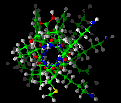 rattle
rattle rattle
rattle Jump to Description or
Examples; explanation of how
commands are documented.
Jump to Description or
Examples; explanation of how
commands are documented.
-bondLength bondlength_value specifies the interatomic distance to which the atom pairs are constrained.
-tolerance tolerance_value specifies the tolerance with which the constraints are enforced.
atom1_list atom2_list are two sets of atom specifications which identify the atom pairs to be constrained.
By default, every angle in the system is constrained to its current value.
Note, however, that the rattle angles command actually constrains the distance between the 1,3 atoms of an angle. Therefore, you need to issue the rattle bonds command before the rattle angles command to constrain the bond distances so that the angle itself can be constant.
 Jump to Syntax or
Description
Jump to Syntax or
Description
rattle bonds -bondLength 1.0000 -tolerance 1e-4 "*:WTR_*:H11" "*:WTR_*:O1"All the bonds between H11 and O1 in residues WTR of all molecules in a box of water molecules are constrained to bond lengths of 1.0 Å during dynamics, with a tolerance of 1e-4 Å.
rattle angles -angleValue 109.0 \
-tolerance 1e-4 "*:WTR_*:H11" "*:WTR_*:O1" "*:WTR_*:H12"
All the angles formed by H11, O1, and H12 in residues WTR of all
molecules are constrained to an angle of 109° during dynamics,
with a tolerance of 1e-4°.
rattle water -waterType SPC -tolerance 1e-4All the water molecules are maintained at the fixed geometry of the SPC model during dynamics, with a tolerance of 1e-4. Furthermore, the nonbond parameters used for water are changed to those of the SPC model.
This command also makes use of the molGeom command to fix the geometry of the water molecules.
rattle water -waterType CURRENT -tolerance 1e-4All water molecules are maintained at the current geometry during dynamics. The current forcefield is used for water.
rattle bondsConstrain all bonds in molecules to the current bond lengths. The tolerance is set at the default of 1e-5 Å.
 Main
access page
Main
access page  Advanced-Use access.
Advanced-Use access.
 List of BTCL commands
List of BTCL commands
 pseudoAtom command
pseudoAtom command
 readFile command
readFile command
Copyright Biosym/MSI